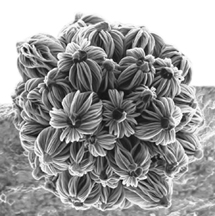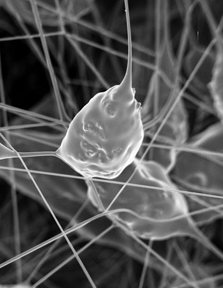Nanotechnology, nano dust and health effects
By Dr. Hemantha WICKRAMATILLAKE
Director General, National Institute of Occupational Safety and
Health, Ministry of Labour Relations
 |
|
Scientists are
experimenting with substances at the nanoscale |
Nanotechnology, shortened to “nanotech”, is the study of the control
of matter on an atomic and molecular scale. Generally, nanotechnology
deals with structures of the size 100 nanometres or smaller in at least
one dimension, and involves developing materials or devices within that
size. Nanotechnology is very diverse, ranging from extensions of
conventional device physics to completely new approaches based upon
molecular self-assembly, from developing new materials with dimensions
on the nanoscale to investigating whether matter can be controlled at
nanoscale. A nanoparticle is a particle with lengths in 2 or 3
dimensions between 1 to 100 nm that may or may not have size related
intensive properties. Nanomaterials are generally in the 1-100 nm range
and can be composed of many different base materials (carbon, silicon,
and metals such as gold, cadmium, and selenium).
Nanomaterials also have different shapes: referred to by terms such
as nanotubes, nanowires, crystalline structures such as quantum dots,
and fullerenes. Nanomaterials often exhibit very different properties
from their respective bulk materials: greater strength, conductivity,
and fluorescence, among other properties. For many types of
nanoparticles, 50-100% of the atoms may be on the surface, resulting in
greater reactivity than bulk materials. In order to understand the
unusual world of nanotechnology, we need to get an idea of the units of
measure involved. A centimetre is one-hundredth of a metre, a millimetre
is one-thousandth of a metre, and a micrometre is one-millionth of a
metre, but all of these are still huge compared to the nanoscale. A
nanometre (nm) is one-billionth of a metre, smaller than the wavelength
of visible light and a hundred-thousandth the width of a human hair. As
small as a nanometre is, it’s still large compared to the atomic scale.
An atom has a diameter of about 0.1 nm. Atoms are the building blocks
for all matter in our universe. On the nanoscale, we can potentially put
these atoms together to make almost anything. Experts sometimes disagree
about what constitutes the nanoscale, but in general, one can think of
nanotechnology dealing with anything measuring between 1 and 100 nm.
Larger than that is the microscale, and smaller than that is the atomic
scale. Particles in the nanometre size range do occur both in nature
(e.g. volcano eruptions) and as an incidental byproduct of existing
industrial processes (e.g. welding, smelting etc.). One concern about
small particles that are less than 10 (microns) is that they are
respirable and reach the alveolar spaces of the lungs.
The current nanotechnology revolution differs from past industrial
processes because nanomaterials are being engineered and fabricated from
the bottom up, rather than occurring as a byproduct of other activities.
The nanomaterials being engineered have different and unexpected
properties compared to those of the parent compounds. Since their
properties are different when they are small, it is expected that they
will have different effects on the body and will need to be evaluated
separately from the parent compounds for toxicity. Currently
nanomaterials are being introduced into the commercial market. Some
nanmoaterials are used as catalyst supports in catalytic converters;
nanosized titanium dioxide particles are used as a component of
sunscreens; carbon nanotubes have been used to strengthen tennis
rackets; components in silicon chips are reaching the 45 to 65 nm range.
Research and industrial labs are working at the intersection of
engineering and biology to extend uses to medicine as well as all areas
of engineering. The impact is expected to revolutionize these areas.
Government agencies in the US and Europe are beginning to fund
toxicology research to understand the hazards of these materials before
they become widely available.
Quantum mechanics
One of the exciting and challenging aspects of the nanoscale is the
role that quantum mechanics plays in it. The rules of quantum mechanics
are very different from classical physics, which means that the
behaviour of substances at the nanoscale can sometimes contradict common
sense by behaving erratically. Usually one cannot walk up to a wall and
immediately teleport (transport by dematerializing at one point and
assembling at another) to the other side of it, but at the nanoscale an
electron can; it is called electron tunnelling. Substances that are
insulators, meaning they can’t carry an electric charge in bulk form,
might become semiconductors when reduced to the nanoscale. Melting
points can change due to an increase in surface area.
Much of nanoscience requires that we forget what we know and start
learning all over again. So what does this all mean? Right now, it means
that scientists are experimenting with substances at the nanoscale to
learn about their properties and how it might be able to take advantage
of them in various applications. Engineers are trying to use nano-size
wires to create smaller, more powerful microprocessors. Doctors are
searching for ways to use nanoparticles in medical applications. Still,
there is a long way to go before nanotechnology dominates the technology
and medical markets.
 Currently, scientists find two nano-size structures of particular
interest: nanowires and carbon nanotubes. Nanowires are wires with a
very small diameter, sometimes as small as 1 nanometre. Scientists could
build tiny transistors for computer chips and other electronic devices.
In the recent past, carbon nanotubes have overshadowed nanowires. A
carbon nanotube is a nano-size cylinder of carbon atoms. With the right
arrangement of atoms, one can create a carbon nanotube that’s hundreds
of times stronger than steel, but six times lighter. Engineers plan to
make building material out of carbon nanotubes, particularly for items
like cars and airplanes. Carbon nanotubes can also be effective
semi-conductors with the right arrangement of atoms. Some products
already manufactured are sunscreens containing nanoparticles of zinc
oxide or titanium oxide, self-cleaning glass which uses nanoparticles to
make the glass photocatalytic and hydrophilic, clothing where fabrics
are coated with a thin layer of zinc oxide nanoparticles, manufacturers
can create clothes that give better protection from UV radiation,
scratch-resistant coatings, antimicrobial bandages using nanoparticles
of silver where silver ions block microbes’ cellular respiration, tennis
rackets and swimming pool cleaners and disinfectants with nano-sized oil
drops mixed with a bactericide. Currently, scientists find two nano-size structures of particular
interest: nanowires and carbon nanotubes. Nanowires are wires with a
very small diameter, sometimes as small as 1 nanometre. Scientists could
build tiny transistors for computer chips and other electronic devices.
In the recent past, carbon nanotubes have overshadowed nanowires. A
carbon nanotube is a nano-size cylinder of carbon atoms. With the right
arrangement of atoms, one can create a carbon nanotube that’s hundreds
of times stronger than steel, but six times lighter. Engineers plan to
make building material out of carbon nanotubes, particularly for items
like cars and airplanes. Carbon nanotubes can also be effective
semi-conductors with the right arrangement of atoms. Some products
already manufactured are sunscreens containing nanoparticles of zinc
oxide or titanium oxide, self-cleaning glass which uses nanoparticles to
make the glass photocatalytic and hydrophilic, clothing where fabrics
are coated with a thin layer of zinc oxide nanoparticles, manufacturers
can create clothes that give better protection from UV radiation,
scratch-resistant coatings, antimicrobial bandages using nanoparticles
of silver where silver ions block microbes’ cellular respiration, tennis
rackets and swimming pool cleaners and disinfectants with nano-sized oil
drops mixed with a bactericide.
New products
New products incorporating nanotechnology are coming out everyday.
Any toxic effects of nanomaterials will be very specific to the type
of base material, size, ligands, and coatings. One of the earliest
observations was that nanomaterials, also called ultrafine particles
(100 nm), showed greater toxicity than fine particulates (2.5 um) of the
same material on a mass basis. This has been observed with different
types of nanomaterials, including titanium dioxide, aluminum trioxide,
carbon black, cobalt, and nickel. For example, Oberdorster (1994) found
that 21 nm titanium dioxide particles produced 43 fold more inflammation
(as measured by the influx of polymorphonuclear leucocytes, a type of
white blood cell, into the lung) than 250 nm particles based on the same
mass instilled into animal lungs. Though multiple studies have shown
that nano-sized particles may be more toxic than micro-sized particles,
this is not always the case. Wang (2008) showed that nanoscale titanium
dioxide when inhaled could travel to the brain by way of olfactory
neurons.
Once in the brain, it caused oxidative stress and neuronal
degeneration in several areas, including the hippocampus which is
involved with short-term memory. Nanoscale titanium dioxide joins
several other types of nanomaterials (manganese oxide, nano carbon, and
some viruses) that can enter the brain directly by means of the
olfactory pathway from the nose. Researchers led by Ken Donaldson of the
University of Edinburgh Centre for Inflammation Research, UK, found that
in mice, long, straight, multi-walled carbon nanotubes can cause the
same kind of damage (cancer) as that inflicted by asbestos fibres when
they are injected into the lung’s outer lining, called the mesothelium.
Nanoscale titanium dioxide has shown very different properties from
the micron scale material in tests of lung toxicity. Fourteen to 40 nm
titanium dioxide produced lung cancer in rats at doses of 10 mg/m3;
micron sized dust produced cancer only at very high doses (250 mg/m3).
Based on these results the National Institute of Occupational Safety and
Health (NIOSH) issued a recommended safe occupational exposure limit of
0.1 mg/m3 for nanoscale material and 1.5 mg/m3 for micron size material.
The International Agency for Research on Cancer (IARC) has also
determined that titanium dioxide is a category 2B carcinogen: possibly
carcinogenic to humans. There is currently no consensus about the
ability of nanoparticles to penetrate through the skin. Particles in the
micrometre range are generally thought to be unable to penetrate through
the skin. The outer skin consists of a 10 m thick, tough layer of dead
keratinized cells (stratum corneum) that is difficult to pass for
particles, ionic compounds, and water soluble compounds. Micronized
titanium dioxide (40 nm) is currently being used in sunscreens and
cosmetics as sun protection. The nano particles are transparent and do
not give the cosmetics the white, chalky appearance that coarser
preparations did. Carbon nanotubes (CNT) can have either single or
multiple layers of carbon atoms arranged in a cylinder. The dimensions
of typical single wall carbon nanotubes (SWCNT) are about 1-2 nm in
diameter by 0.1 um in length.
Multiple wall carbon nanotubes (MWCNT) are 20 nm in diameter and 1 mm
long. CNT may behave like fibres in the lung. They have properties very
different from bulk carbon or graphite. They have great tensile strength
and are potentially the strongest, smallest fibres known. CNT have been
tested in short term animal tests of pulmonary toxicity and the results
suggest the potential for lung toxicity though there are questions about
the nature of the toxicity observed and the doses used. Fullerenes are
another category of carbon based nanoparticles.
The most common type has a molecular structure of C60 which take the
shape of a ball shaped cage of carbon particles arranged in pentagons
and hexagons. Fullerenes have many potential medical applications as
well as applications in industrial coatings and fuel cells, so a number
of preliminary toxicology studies have been done with them.
In cell culture, different types of fullerenes produced cell death at
concentrations of 1 to 15 ppm in different mammalian cells when
activated by light (as discussed in Colvin, 2003). Sayes (2004) found
that toxicity could be eliminated when carboxyl groups were substituted
on the fullerene surface to increase water solubility.
Nanoparticles (0.1 um) are generally similar in size to proteins in
the body. They are considerably smaller than many cells in the body.
Human alveolar macrophages are 24 nm in diameter and red blood cells are
7-8 nm in diameter. Cells growing in tissue culture will pick up most
nanoparticles. Thus, the ability to be taken up by cells is being used
to develop nanosized drug delivery systems and does not inherently
indicate toxicity. Gold nanoparticles are being investigated as
transfection agents, DNA-binding agents, protein inhibitors and other
biomedical applications.
Once in the body, some types of nanoparticles may have the ability to
translocate and be distributed to other organs, including the central
nervous system.
 Silver, albumin, and carbon nanoparticles all showed systemic
availability after inhalation exposure. Quantum dots (QD) are
nanocrystals containing 1000 to 100,000 atoms and exhibiting unusual
quantum effects such as prolonged fluorescence. They are being
investigated for use in immunostaining as alternatives to fluorescent
dyes. Silver, albumin, and carbon nanoparticles all showed systemic
availability after inhalation exposure. Quantum dots (QD) are
nanocrystals containing 1000 to 100,000 atoms and exhibiting unusual
quantum effects such as prolonged fluorescence. They are being
investigated for use in immunostaining as alternatives to fluorescent
dyes.
The most commonly used material for the core crystal is
cadmium-selenium, which exhibits bright fluorescence and high
photostability. Both bulk cadmium and selenium are toxic to cells. One
of the primary sites of cadmium toxicity in vivo is the liver.
Working safely with nanomaterials
How to work safely with Nanomaterials. The preliminary conclusions to
be drawn from the toxicology studies to date are that some types of
nanomaterials can be toxic, if they are not bound up in a substrate and
they are available to the body.
Multiple government organizations are working to fund and assemble
toxicology information on these materials.
Because they are so small, nanoparticles follow airstreams more
easily than larger particles, so they will be easily collected and
retained in standard ventilated enclosures such as fume hoods. In
addition, nanoparticles are readily collected by HEPA filters.
Respirators with HEPA filters will be adequate protection for
nanoparticles in case of spills of large amounts of material. Working
safely with nanomaterials involves following standard procedures that
would be followed for any particulate material with known or uncertain
toxicity: preventing inhalation, dermal, and ingestion exposure.
Concerning skin contact, Maynard (Authorm) former superior officer),
found clumps of nanoropes on the gloves of workers removing the
synthesized materials from the reactors. Since the ability of
nanoparticles to penetrate the skin is uncertain at this point, chemical
resistant gloves should be worn when handling particulate and solutions
containing particles. One potential safety concern with nanoparticles is
fires and explosions if large quantities of dust are generated during
reactions or production. This is expected to become more of a concern
when reactions are scaled up to pilot plant or production levels.
As nanotechnology emerges and evolves, potential environmental
applications and human health and environmental implications are under
consideration by the EPA and local regulators.
There are currently no guidelines from the EPA specifically
addressing disposal of waste nanomaterials.
It seems that regulation at some level is inevitable. The following
waste management guidance applies to nanomaterial-bearing waste streams
consisting of:
Pure nanomaterials (e.g., carbon nanotubes), items contaminated with
nanomaterials (e.g., wipes/PPE), liquid suspensions containing
nanomaterials, solid matrixes with nanomaterials that are friable or
have a nanostructure loosely attached to the surface such that they can
reasonably be expected to break free or leach out when in contact with
air or water, or when subjected to reasonably foreseeable mechanical
forces.
(The writer was formerly a Senior Environmental Health Scientist with
the MRC, UK and an Environmental Health Specialist with the World Health
Organisation, Europe Office)
|

